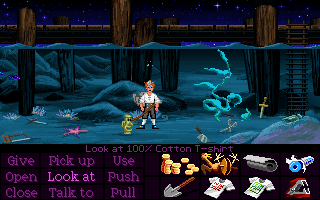
• • Patrick Mundy Series Original version,,,,,, Special edition,,,, Release 16-color version October 1990 ( 1990-10) 256-color version December 1990 ( 1990-12) CD-ROM version 1992 Special edition July 15, 2009 Mode(s) The Secret of Monkey Island is a developed and published. It takes place in a fantastic version of the during the. The player assumes the role of, a young man who dreams of becoming a pirate and explores fictional islands while solving puzzles. The game was conceived in 1988 by Lucasfilm employee, who designed it with and.

Gilbert's frustrations with contemporary adventure titles led him to make the 's death almost impossible, which meant that gameplay focused the game on exploration. The atmosphere was based on that of the theme park ride.
Nov 09, 2003 The Secret of Monkey Island. You may be able to find a Monkey Island bounty pack including The Secret of Monkey Island, Monkey Island 2 'LeChuck's. The Secret of Monkey Island is the first installment of the series of games. 'Excerpted from. Search for th’ treasure of Big Whoop in Monkey Island 2: LeChuck’s Revenge – Special Edition, featurin’ HD graphics and bonus content! Monkey Island 2: LeChuck's Revenge is an adventure game developed and published by LucasArts in 1991. It was the second game of the Monkey Island series, following.
The Secret of Monkey Island was the fifth game built with the engine, which was heavily modified to include a more user-friendly interface. Critics praised The Secret of Monkey Island for its humor, audiovisuals, and gameplay. The game spawned a number of sequels, collectively known as the. Gilbert, Schafer and Grossman also led the development of the sequel. LucasArts released a of the original in 2009, which was also well received by the gaming press. Contents • • • • • • • • • • • Gameplay [ ] The Secret of Monkey Island is a played from a. Via a interface, the player guides protagonist Guybrush Threepwood through the game's world and interacts with the environment by selecting from twelve verb commands (nine in newer versions) such as 'talk to' for communicating with characters and 'pick up' for collecting items between commands and the world's objects in order to successfully solve puzzles and thus progress in the game.
While conversing with other characters, the player may choose between topics for discussion that are listed in a; the game is one of the first to incorporate such a system. The in-game action is frequently interrupted.
Like other, The Secret of Monkey Island features a design philosophy that makes the player character's death nearly impossible (Guybrush does drown if he stays underwater for more than ten minutes). Fire Hydrant Autocad there. Led the game's development and conceived its plot (2011 photo).
Gilbert soon realised that it would be difficult to design the game by himself; he decided to join forces with and, both of whom he hired for Lucasfilm. The game's insult sword fighting mechanics were influenced by swashbuckling movies starring, which Gilbert, Schafer and Grossman often watched for inspiration. They noticed that pirates in those films often taunted their opponents instead of attacking them, which gave the designers the idea to base the game's duels on insults rather than combat. Writer helped them write the insults during a visit to Lucasfilm's headquarters. Many of Gilbert's original gameplay ideas were abandoned during the production process, although he stated that 'most of that stuff was left out for a reason'. (left, 2011 photo) and (right, 2007 photo) co-wrote the game's plot with Gilbert and supplied programming. The game's plot, as described by Dave Grossman: 'It's a story about this young man who comes to an island in search of his life's dream.
He's pursuing his career goals and he discovers love in the process and winds up thinking that was actually more important than what he was doing to begin with. You’re laughing, but there's actually something deeper going on as well.' When work on the plot began, Gilbert discovered that Schafer's and Grossman's writing styles were too different to form a cohesive whole: Grossman's was 'very kind of a dry, sarcastic humor' and Schafer's was 'just a little more in your face'. In reaction, Gilbert assigned them to different characters and story moments depending on what type of comedy was required. Grossman believed that this benefited the game's writing, as he and Schafer 'were all funny in slightly different ways, and it worked well together'. Schafer and Grossman wrote most of the dialogue while they were programming the game; as a result, much of it was improvised.
Some of the dialogue was based on the designers' personal experiences, such as Guybrush's line 'I had a feeling in hell there would be mushrooms', which came from Schafer's own hatred of fungi. The game's world and characters were designed primarily by Gilbert. After having read ' historical fantasy novel, he decided to add themes to the game's plot. He also cited Powers' book as an influence on the characters, particularly those of Guybrush and LeChuck. Inspiration for the game's ambiance came from Gilbert's favorite childhood amusement park ride,.